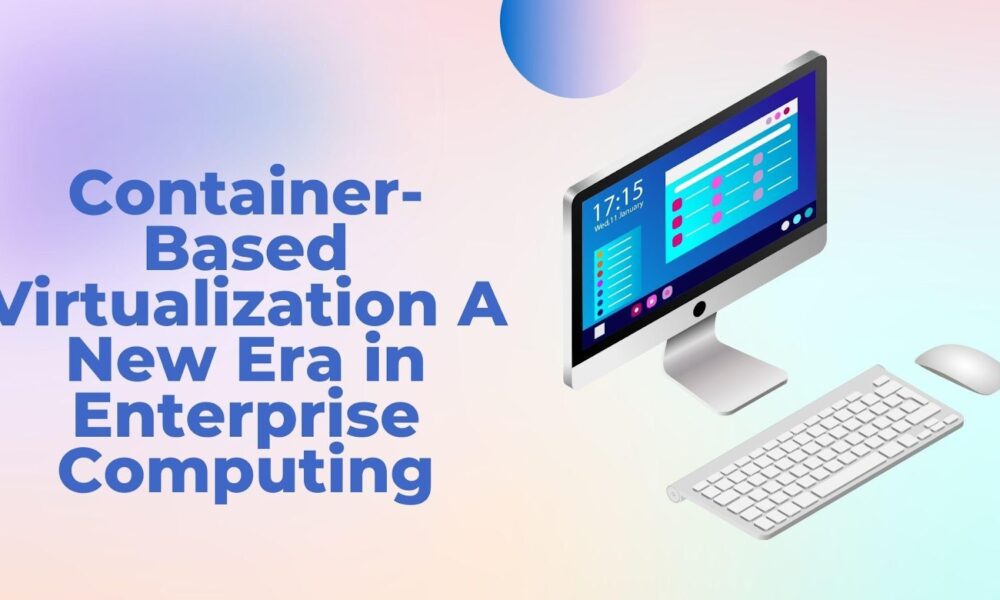Container-Based Virtualization: A New Era in Enterprise Computing

Modern enterprises are increasingly adopting container-based virtualization to enhance software development, deployment, and scalability. This approach optimizes resource utilization while ensuring portability across diverse computing environments. In his latest research, Srinivas Chippagiri provides a comprehensive analysis of containerization, emphasizing its architectural components, security implications, and cloud integration patterns. His study explores how organizations are leveraging containers to build robust, scalable, and secure enterprise computing solutions.
The Evolution of Containerization
Containerization has evolved from basic application isolation techniques to a sophisticated ecosystem supporting distributed architectures. Unlike traditional virtualization, containers allow multiple applications to run in isolated user-space instances without requiring separate operating system installations. This ensures better resource efficiency, faster deployment, and improved scalability.
The rise of container orchestration has further streamlined container management by enabling automated scaling, load balancing, and system resilience. With increased adoption in cloud-native architectures, containerization is now a cornerstone of modern enterprise computing.
Architectural Components of Containerization
Container-based virtualization is built on four primary layers:
- Hardware Infrastructure Layer – Provides the necessary computing resources, ensuring reliability in industrial applications.
- Host Operating System – Implements kernel features that enable efficient resource sharing and security enforcement.
- Container Engine – Manages container runtime, ensuring secure operations with advanced namespace isolation.
- Application Layer – Houses containerized workloads, allowing seamless execution across multiple environments.
This structured approach enhances operational efficiency, security, and workload management.
Security Challenges in Containerized Environments
While containerization offers several advantages, it also introduces new security challenges. Key concerns include:
- Container Escape Vulnerabilities: Attackers exploiting security gaps to gain access to the host system.
- Supply Chain Risks: Unauthorized modifications in container images leading to security breaches.
- Inadequate Access Control: Improper privilege management increasing the risk of unauthorized access.
To address these risks, organizations are implementing runtime protection mechanisms, network security protocols, and container image verification techniques. Adopting context-aware access controls and integrating AI-driven security monitoring further enhances container security.
Cloud Integration: Enhancing Flexibility and Scalability
The convergence of containerization and cloud computing has transformed how applications are deployed and managed. Organizations are increasingly adopting Container-as-a-Service (CaaS) solutions, allowing seamless integration with cloud-native architectures.
Key benefits include:
- Multi-cloud portability – Ensuring interoperability across different cloud providers.
- Automated resource scaling – Optimizing infrastructure costs based on demand fluctuations.
- Secure deployment pipelines – Implementing continuous integration and delivery (CI/CD) with security validation.
These advancements enable businesses to scale applications efficiently while maintaining robust security and compliance.
Microservices and Containerization: A Perfect Match
Containerization plays a vital role in microservices architecture, where applications are built as loosely coupled, independently deployable services. The synergy between containers and microservices enhances:
- Deployment agility – Rapid iteration and feature releases.
- Fault isolation – Preventing failures in one service from impacting others.
- Optimized resource utilization – Reducing infrastructure overhead.
Modern enterprises are leveraging container-based microservices to improve system resilience and operational efficiency.
Best Practices for Enterprise Adoption
For successful container adoption, enterprises must focus on:
- Security First Approach: Implementing image scanning, role-based access control (RBAC), and encryption.
- Efficient Orchestration: Leveraging Kubernetes and other orchestration tools for automated scaling and monitoring.
- Optimized CI/CD Pipelines: Integrating containers into DevOps workflows for seamless application deployment.
- Performance Monitoring: Using AI-powered observability tools to analyze system behavior and optimize performance.
By following these best practices, businesses can maximize the benefits of containerization while mitigating operational risks.
Future Trends in Container-Based Virtualization
The future of containerization is shaped by emerging technologies and evolving security paradigms. Notable trends include:
- AI-driven workload management – Enhancing predictive analytics for resource optimization.
- Blockchain-based security – Ensuring tamper-proof container registries and authentication mechanisms.
- Edge computing adoption – Expanding containerized applications to distributed environments with low latency requirements.
- Zero-trust security models – Enforcing strict identity verification for containerized applications.
These innovations will further redefine enterprise computing, making it more agile, secure, and scalable.
In conclusion, Containerization is transforming enterprise computing by enhancing deployment agility, security, and scalability. By adopting best practices in security, orchestration, and cloud integration, businesses can unlock the full potential of container-based virtualization. As Srinivas Chippagiri highlights, the future of enterprise IT will be shaped by containerization, microservices, and AI-driven automation, ensuring that organizations remain resilient and future-ready in the digital era.


